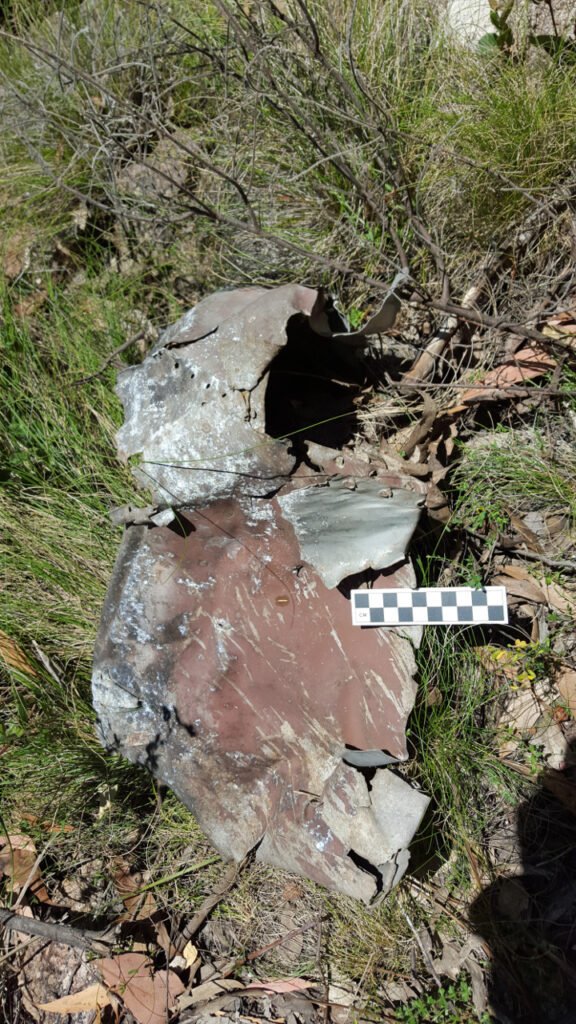The term ‘aviation archaeology’ can be defined as the study of human flight in the atmosphere through the investigation of the material remains associated with the act of flying. Such remains can include buildings and structures, aircraft wreckage and parts, aviation artefacts, and other indirect resources, such as radar sites and anti-aircraft gun positions.
During the late 1950s and early 1960s, enthusiastic amateurs began excavating aircraft crash sites in Britain as a way of collecting souvenirs from the wartime period. As this activity gained momentum, one of the earliest volumes dedicated to what was at the time loosely referred to as ‘aviation archaeology’ was first written by Robertson and published in 1977 as a ‘collector’s guide to aeronautical relics’. Some years later, a television programme documenting the recovery of human remains from Second World War aircraft wrecks in the Netherlands referred to such sites as ‘archaeological treasures’ and discussed some archaeological methodologies including ways to determine the earliest possible date of the crash – known as the terminus post quem – based on the manufacture date of associated artefacts, such as ammunition. However, the first mention in an academic journal of archaeological methodologies being used on a Second World War aviation site was made in 1981 when the use of side-scan sonar to locate the wreck of a Vickers Wellington bomber in Loch Ness was briefly discussed. Such archaeological projects can, of course, include the investigation of civilian and non-military aviation endeavours, however, the majority of the projects conducted thus far have involved sites associated with the military.
During the 1980s and early 1990s it was recognised by some that this expanding field of aviation archaeology needed to be less about the simple ‘acquisition’ of items and more about ‘inquisition’. Today, aviation archaeologists use a wide variety of tools, technologies, and methodologies to learn more about aviation of the past, through the investigation of surviving sites and artefacts.
References
Cornwell, P.D. 1980, ‘Aviation archaeology and the Battle of Britain’, in W.G. Ramsey (ed.), The Battle of Britain: Then and Now (Revised Edition), pp. 317-318. London: Battle of Britain Prints International Limited.
Fix, P.D. 2011, ‘From sky to sea: the case for aeronautical archaeology’, in A. Catsambis, B. Ford and D.L. Hamilton (eds), The Oxford Handbook of Maritime Archaeology, pp. 989–1009. Oxford: Oxford University Press.
Leahy, D.J. 2018, ‘Airfields of the Commonwealth: The archaeology of the Empire Air Training Scheme of World War II’. Unpublished Honours thesis, School of Humanities, University of New England, Armidale, NSW.
Shanahan, F. 2018, ‘Aviation archaeology’, in C. Smith (ed.), Encyclopedia of Global Archaeology. Cham: Springer. Retrieved 15 January 2021 from <https://doi.org/10.1007/978-3-319-51726-1_2531-1>.
Spennemann, D.H.R. 1998, Essays on the Marshallese Past (2nd Edition). Retrieved 15 January 2021 from <http://marshall.csu.edu.au/Marshalls/html/essays/es-ww2-6.html>.
Wood, W.R. 1991, ‘Introduction: archaeology and World War II’, in W.R. Wood (ed.), Archaeological Studies of World War II, pp. 1-2. Museum of Anthropology Monograph Number 10. Columbia: Department of Anthropology, University of Missouri.
Past Aviation Cultures Papers
Bellamy, C. 2018, ‘A discussion on dealing with military aviation crash sites in the Top End of Australia’. Paper presented at the Aviation Cultures Mk. IV conference, University of Sydney, 28 November 2018.
Abstract: The need to protect archaeological relics is a well‐founded principle. As one source has noted ‘archaeological relics are irreplaceable resources that have huge potential to contribute to our understanding of our history and the development of society’. Another source has noted that while ‘preservation in place is the ideal expressed by relevant regulations, it rarely happens’. But is it necessary to put all artefacts into museums? Is the relevance of the item lost when it is relocated and installed in a diorama‐type setting rather than the actual physical crash site location? Which museum should have the artefacts – should they go to local, regional or national museums? This issue is often more complicated than it looks. It is unlikely that significant battlefields can be boxed and put into a museum but what of smaller archaeological sites – such as aircraft crash sites? Major aerial warfare occurred in the Top End of Australia between 10 February 1942 and 12 June 1944, involving the Imperial Japanese Naval Air Force and Imperial Japanese Army Air Force against the Royal Australian Air Force, the Royal Air Force, the United States Army Air Force and the Netherlands East Indies Air Force. Losses due to combat or mechanical issues occurred with many military aircraft crashing in remote areas of the Top End or at sea. The Top End is literally ‘littered’ with such wreck sites. This paper looks briefly at some of the issues in relation to several specific World War II aircraft crash sites in the Top End in the context of government legislation, the military, politics, military enthusiasts and museums.
Leahy, D.J. 2018, ‘‘What are you going to dig up next?’: recent investigations in aviation archaeology’. Paper presented at the Aviation Cultures Mk. IV conference, University of Sydney, 28 November 2018.
Abstract: The term ‘aviation archaeology’ can be defined as the study of humanity’s interaction with flight through the investigation of surviving material remains. Such archaeological studies can add to what has already been learnt from analysis of the historical record and, despite popular belief, not all archaeological investigation involves the excavation or salvage of aircraft artefacts. This presentation will provide a brief overview of some recent projects where members of the archaeological community have expanded our knowledge of aviation sites around the world through the use of modern technologies. It will also present the results of a recent Australian‐based archaeology project that investigated the design, layout and construction of airfields utilised by the schools of the Empire Air Training Scheme during World War II.
Images courtesy Daniel Leahy.





